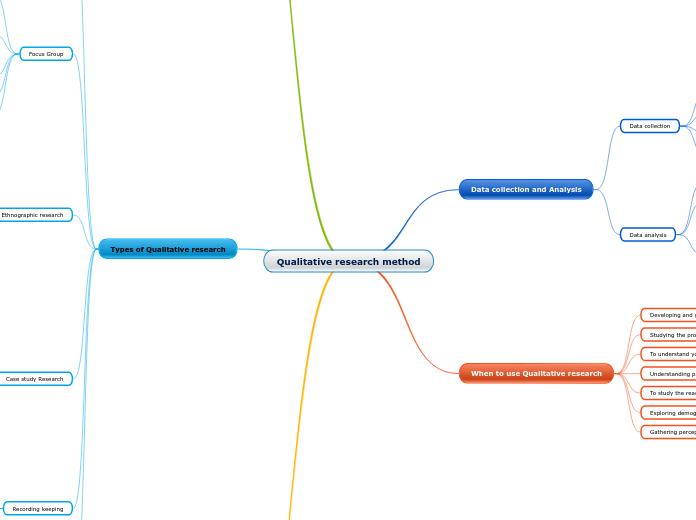Qualitative research method
Data collection and Analysis
Data collection
Non-numeric
Helps to explore decision making
Provide detail insight of respondent
Apply holistic, rich and findings to emerge through careful analysis
Data analysis
Decode word and action
Analyzed social life of the participant
Media
Notes
Video
Audio recording
Text document
When to use Qualitative research
Developing and generating new idea
Studying the product to strengthen your ideas
To understand your weakness and strengths
Understanding participants behaviors and traits
To study the reaction of your respondents
Exploring demographics, segments and group target
Gathering perception data of organization and product
What is Qualitative research?
Collecting a non-numerical data
Less formal
Questions asked
Open-ended questions
Conversational method
Based on disciplines
Psychology
Sociology
Anthropology
Types of Qualitative research
One-on-one interview
Face-to-face/On call interview
Personal interview
Invites opportunities
Detail in-depth
Opportunity
What people believes
Motivation
Collecting meaningful data
Focus Group
Limit number of respondent
6-10 respondent
Elements
What
Why
How
Online survey
Expensive method
Testing new products
Ethnographic research
In-depth observational method
Studies the environement of sample target
Target audience
Organization
City
Constraints
Time consuming
Depends on the expertise
Analyze
Observed
Infer the data
Case study Research
Past few years studies
Development valuable quality research
Use within the area of
Education
Social science
Use in explaining
An organization
an entity
Difficult to operate
Recording keeping
Existing reliable documents
Similar sources information
Similar to going to a library
Books
Articles
Journal
Process of observation
Subjective methodologies
Gather systematic data
Primarily used in equate quality differences
Characteristic
Collect data in real-time
Participants experience real problems
Different forms in collect data
Interviews
Documents
Observation
Solving complex issues
Breaking down
Meaningful inferences
Easy to read & understand participant
Build trust with the researcher
Information obtained
Raw
Unadulterated
